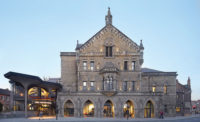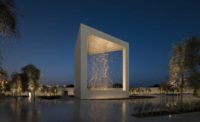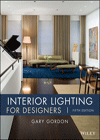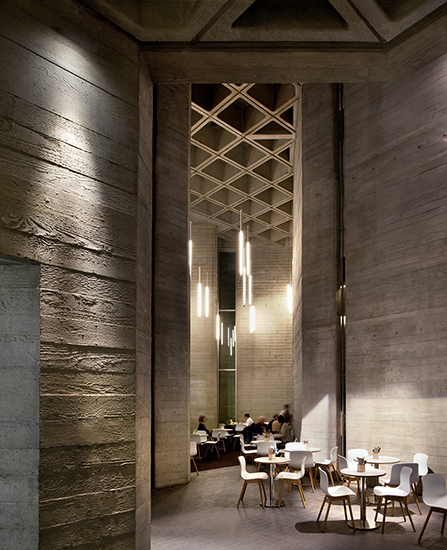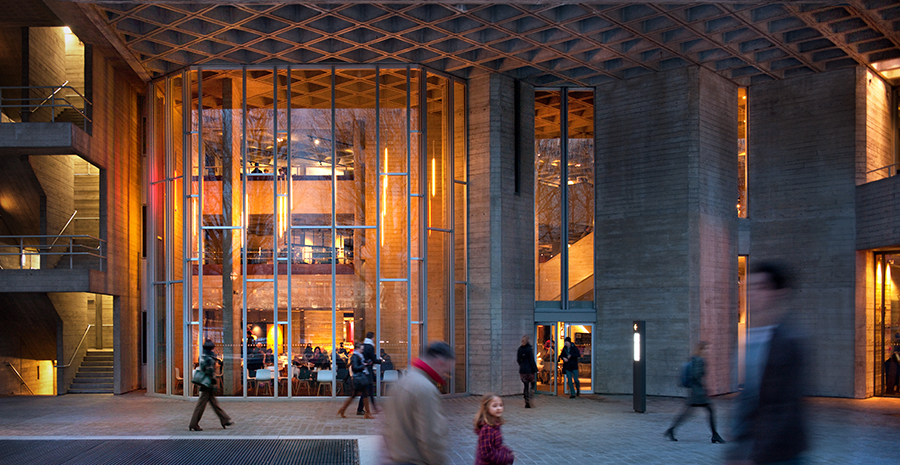Luminous Revivals
The National Theatre

Atelier Ten’s lighting design played a central role in creating a warmer welcome without compromising the building’s distinctive aesthetic or protected fabric. (The National Theatre has been Grade II* listed as a particularly important building of more than special interest by the UK since 1994.)
Photo © Philip Vile

From the riverside, new glazing on the main foyer emits a welcoming glow. Preprogrammed lighting controls shift between four “scenes” from morning to late evening in response to external daylight levels.
Photo © Philip Vile

To minimize damage to the concrete, the designers reused existing brackets for spotlights.
Photo © Philip Vile

The lighting designers developed custom fixtures such as the chandelier in the entrance lobby.
Photo © Philip Vile

Spotlights wash board marked concrete walls in the new Dorfman Theatre foyer.
Photo © Philip Vile

Spotlights wash board marked concrete walls in the first-floor House restaurant.
Photo © Philip Vile

The lighting designers developed custom fixtures.
Photo © Philip Vile

A new café features T5 tubes are suspended horizontally among a tracery of electrical conduit and sprinkler pipes below an exposed concrete ceiling.
Photo © Philip Vile

T5 tubes create individual pendants in a remodelled foyer on the building’s east side, where they are paired with horizontal strip-lights set within a slatted timber ceiling.
Photo © Philip Vile

An elevated public route leads through the back-of-house facilities, allowing views into design offices, workshops and a vast set-painting studio. Industrial light fixtures reflect the architect’s characterization of the theater as a ‘creative factory’, but the role of lighting in these large volumes is primarily functional rather than atmospheric. High-performance luminaires are fitted with reflectors that give an even distribution of light at 1500 lux.
Photo © Philip Vile

An elevated public route leads through the back-of-house facilities, allowing views into design offices, workshops and a vast set-painting studio. Industrial light fixtures reflect the architect’s characterization of the theater as a ‘creative factory’, but the role of lighting in these large volumes is primarily functional rather than atmospheric. High-performance luminaires are fitted with reflectors that give an even distribution of light at 1500 lux.
Photo © Philip Vile

Within the grid of the egg-crate ceiling slabs, bronze-anodized cylindrical downlights are clustered in small, irregular groups. To avoid light spilling into the coffers, which the designers wanted to keep dark, they are fitted with gold reflectors that also add warmth to the light emitted by 2700K LED modules. LED spotlights with honeycomb louvers that emulate the quality of old PAR lamps are set into floors at the base of walls and columns, “grazing” the concrete surfaces with light to reveal their texture.
Photo © Philip Vile

On the terraces, open to the public at all hours, Atelier Ten resisted the demands of safety advisors for overhead lighting, demonstrating that knee-high LED strips secreted in the balustrades could give sufficient light.
Photo © Philip Vile

The enjoyment of darkness is evident in the external spaces.
Photo © Philip Vile

At night, visitors’ views of illuminated facades across the river are enhanced by their own position in the half- dark.
Photo © Philip Vile















London
Few London buildings divide opinion so sharply as the National Theatre on the south bank of the Thames. Built by Denys Lasdun and completed in 1976, the Brutalist complex is decried by some as grim and forbidding but loved by many for its spatial and material virtuosity. Its recent $120 million renovation by architect Haworth Tompkins encompasses the expansion of the back-of-house facilities, the remodeling of an auditorium, and the reorganization and enlargement of the front of house. Here, lighting design played a central role in creating a warmer welcome without compromising the building’s distinctive aesthetic or protected fabric. (The National Theatre has been Grade II* listed as a particularly important building of more than special interest by the UK since 1994.)
Extending across the building’s north side and ranging from single to triple height, the main foyer is an essay in the plastic potential of poured-in-place concrete. Heavily board-marked walls and piers carry deep coffered slabs that jetty out beyond the glazing line to form outdoor terraces. Lasdun made careful use of shadow to reveal the sculptural and textural qualities of the structure, but a 1990s renovation left the spaces overbright and surfaces cluttered with theatrical lighting fixtures.
Haworth Tompkins and lighting designer Atelier Ten aimed to restore the foyer’s clarity and intimacy, with a scheme that gives as much weight to darkness as to light. Illumination was introduced in carefully controlled pools and patches, as required to aid orientation or to identify areas for congregation. Café tables might be illuminated to 300 lux, but the average across the floor remains around 100 lux. “We had to learn not to be frightened of the dark,” says Jonathan Gittins, director of Atelier Ten.
The unshowy approach belies hidden complexity. A desire to reference the building’s material details and a requirement to reuse the existing wiring and lighting points called for the development of 40 types of custom fixtures, in three families: downlights, spotlights, and pendants.
Within the grid of the egg-crate ceiling slabs, bronze-anodized cylindrical downlights are clustered in small, irregular groups. To avoid light spilling into the coffers, which the designers wanted to keep dark, they are fitted with gold reflectors that also add warmth to the light emitted by 2700K LED modules.
LED spotlights with honeycomb louvers that emulate the quality of old PAR lamps are set into floors at the base of walls and columns, “grazing” the concrete surfaces with light to reveal their texture. “The warmth of the light also makes the concrete look friendlier and more alive,” says Gittins.
Bright accents are formed by “chandeliers” of red and white pendant lights installed at key points, such as the glazed entrance lobby, where they lend a rouge< blush to the béton brut. The pendants are T5 fluorescent tubes with gel sleeves, and these appropriately utilitarian lamps are also deployed in various configurations across other areas of the building, providing a sense of coherence.
In a new café created from a loading bay in the northeast corner and treated largely as found, T5 tubes are suspended horizontally among a tracery of electrical conduit and sprinkler pipes below an exposed concrete ceiling. They appear again as individual pendants in a second remodeled foyer on the building’s east side, where they are paired with horizontal strip lights set within a slatted timber ceiling.
From this space, an elevated public route leads through credits the back-of-house facilities, allowing views into design offices, workshops, and a vast set-painting studio. Industrial light fixtures reflect the architect’s characterization of the theater as a “creative factory,” but the role of lighting in these large volumes is primarily functional rather than atmospheric. High-performance luminaires are fitted with reflectors that give an even distribution of light at 1,500 lux.
The appreciation of darkness is again evident in the external spaces. On the west-side terraces, open to the public at all hours, Atelier Ten resisted the demands of safety advisors for overhead lighting, demonstrating that knee-high LED strips secreted in the balustrades could give sufficient light. At night, visitors’ views of illuminated facades across the river are enhanced by their own position in the halfdark. As in the foyers and bars, the lighting of the public realm eschews dramatic display to carve out intimate, inviting spaces from which to watch the theater of life.
PeopleArchitect: Haworth Thompkins Lighting Designer: Atelier Ten
Engineers: Consultant: Gross. Max. (landscape); Arup (acoustics); Charcoalblue (theater) General contractor: Lendlease (construction management) Photographer: Philip Vile Client: Royal National Theatre Size: 176,000 square feet Cost: $120 million Completion date: May 2015
|
ProductsLighting: Aether lighting: 40 custom luminaire types used in front of house areas, including spotlights, downlights, and pendants KKDC: Liniglow and Timi linear LED , SEN 47- used in front of house areas including bars and House restaurant Iguzzini: Laserblade wall wash – meeting rooms Etap: Workshop luminaires, Kardo custom built luminaires for Cottesloe Room Wila: Econnect LED Nero, Tentec LED Power Nero – general downlights Philips: iW Burst Powercore, Riga linear LED - External public realm lighting Lighting Controls: Lutron QS system
Lighting Controls: Lutron
|

